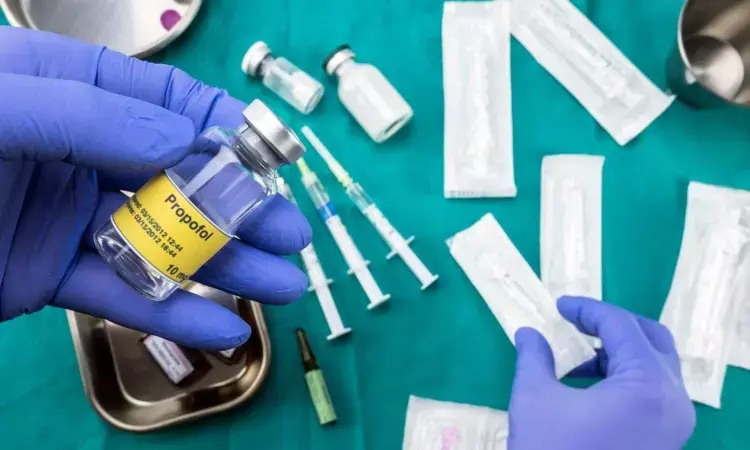- Home
- Medical news & Guidelines
- Anesthesiology
- Cardiology and CTVS
- Critical Care
- Dentistry
- Dermatology
- Diabetes and Endocrinology
- ENT
- Gastroenterology
- Medicine
- Nephrology
- Neurology
- Obstretics-Gynaecology
- Oncology
- Ophthalmology
- Orthopaedics
- Pediatrics-Neonatology
- Psychiatry
- Pulmonology
- Radiology
- Surgery
- Urology
- Laboratory Medicine
- Diet
- Nursing
- Paramedical
- Physiotherapy
- Health news
- Fact Check
- Bone Health Fact Check
- Brain Health Fact Check
- Cancer Related Fact Check
- Child Care Fact Check
- Dental and oral health fact check
- Diabetes and metabolic health fact check
- Diet and Nutrition Fact Check
- Eye and ENT Care Fact Check
- Fitness fact check
- Gut health fact check
- Heart health fact check
- Kidney health fact check
- Medical education fact check
- Men's health fact check
- Respiratory fact check
- Skin and hair care fact check
- Vaccine and Immunization fact check
- Women's health fact check
- AYUSH
- State News
- Andaman and Nicobar Islands
- Andhra Pradesh
- Arunachal Pradesh
- Assam
- Bihar
- Chandigarh
- Chattisgarh
- Dadra and Nagar Haveli
- Daman and Diu
- Delhi
- Goa
- Gujarat
- Haryana
- Himachal Pradesh
- Jammu & Kashmir
- Jharkhand
- Karnataka
- Kerala
- Ladakh
- Lakshadweep
- Madhya Pradesh
- Maharashtra
- Manipur
- Meghalaya
- Mizoram
- Nagaland
- Odisha
- Puducherry
- Punjab
- Rajasthan
- Sikkim
- Tamil Nadu
- Telangana
- Tripura
- Uttar Pradesh
- Uttrakhand
- West Bengal
- Medical Education
- Industry
Study Explores Ciprofol for Painless Hysteroscopy: Promising Alternative to Reduce Injection Pain

Hysteroscopy is widely accepted as the primary method for diagnosing and treating intrauterine conditions. Despite its effectiveness, certain hysteroscopic procedures like cervical dilation and endometrial curettage can be quite painful. To enhance patient comfort and procedural success, painless hysteroscopy techniques have been developed and are commonly employed in medical practice. The current approach involves using a combination of propofol and opioid intravenous anesthesia to ensure painless diagnosis and treatment during hysteroscopy. Recent double-blind, randomized controlled trial that compared the efficacy and safety of ciprofol versus propofol in patients undergoing painless hysteroscopy. The study included 217 participants, with 109 in the ciprofol group and 108 in the propofol group.
The primary outcome was injection pain, which was significantly lower in the ciprofol group compared to the propofol group (18.35% vs. 40.74%). The participants in the ciprofol group also had a lower percentage of moderate to severe pain (2.75% vs. 19.44%).
The secondary outcomes showed that the sedation success rate was 100% in both groups. The anesthesia success rate was comparable between the two groups (79.82% vs. 87.96%). The ciprofol group had a lower incidence of adverse events (27.52% vs. 45.37%), including a lower rate of nausea/vomiting (0% vs. 7.41%) and body movement during the examination (9.17% vs. 19.44%). The ciprofol group also had a lower severity level of adverse events. Patient satisfaction was significantly higher in the ciprofol group compared to the propofol group.
Hemodynamic Parameters Comparison
Regarding hemodynamic parameters, the ciprofol group had significantly higher systolic blood pressure, diastolic blood pressure, and mean arterial pressure compared to the propofol group at the time of cervical dilation and consciousness recovery. This indicates that ciprofol has a smaller impact on blood pressure and more stable hemodynamics compared to propofol. In conclusion, this study found that ciprofol exhibits comparable efficacy to propofol, but is associated with less injection pain, fewer adverse events, higher patient satisfaction, and more stable hemodynamics when used for general anesthesia during painless hysteroscopy. The results suggest that ciprofol may be a promising sedative option for hysteroscopy procedures.
Key Points
1. This was a double-blind, randomized controlled trial that compared the efficacy and safety of ciprofol versus propofol in patients undergoing painless hysteroscopy, with 217 total participants.
2. The primary outcome showed that injection pain was significantly lower in the ciprofol group compared to the propofol group (18.35% vs. 40.74%), and the ciprofol group had a lower percentage of moderate to severe pain (2.75% vs. 19.44%).
3. The secondary outcomes showed that the sedation success rate was 100% in both groups, the anesthesia success rate was comparable, but the ciprofol group had a lower incidence of adverse events (27.52% vs. 45.37%) including less nausea/vomiting and body movement, as well as lower severity of adverse events. Patient satisfaction was also significantly higher in the ciprofol group.
4. Regarding hemodynamic parameters, the ciprofol group had significantly higher systolic blood pressure, diastolic blood pressure, and mean arterial pressure compared to the propofol group at the time of cervical dilation and consciousness recovery, indicating ciprofol has a smaller impact on blood pressure and more stable hemodynamics.
5. The study found that ciprofol exhibits comparable efficacy to propofol, but is associated with less injection pain, fewer adverse events, higher patient satisfaction, and more stable hemodynamics when used for general anesthesia during painless hysteroscopy.
6. The results suggest that ciprofol may be a promising sedative option for hysteroscopy procedures.
Reference –
Li A, Li N, Zhu L, Xu Z, Wang Y, Li J, Zhang G. The efficacy and safety of ciprofol versus pro-pofol in patients undergoing painless hysteroscopy: a randomized, double-blind, controlled trial. BMC Anesthesiol. 2024 Nov 12;24(1):411. doi: 10.1186/s12871-024-02787-0. PMID: 39533194; PMCID: PMC11555848.
MBBS, MD (Anaesthesiology), FNB (Cardiac Anaesthesiology)
Dr Monish Raut is a practicing Cardiac Anesthesiologist. He completed his MBBS at Government Medical College, Nagpur, and pursued his MD in Anesthesiology at BJ Medical College, Pune. Further specializing in Cardiac Anesthesiology, Dr Raut earned his FNB in Cardiac Anesthesiology from Sir Ganga Ram Hospital, Delhi.


